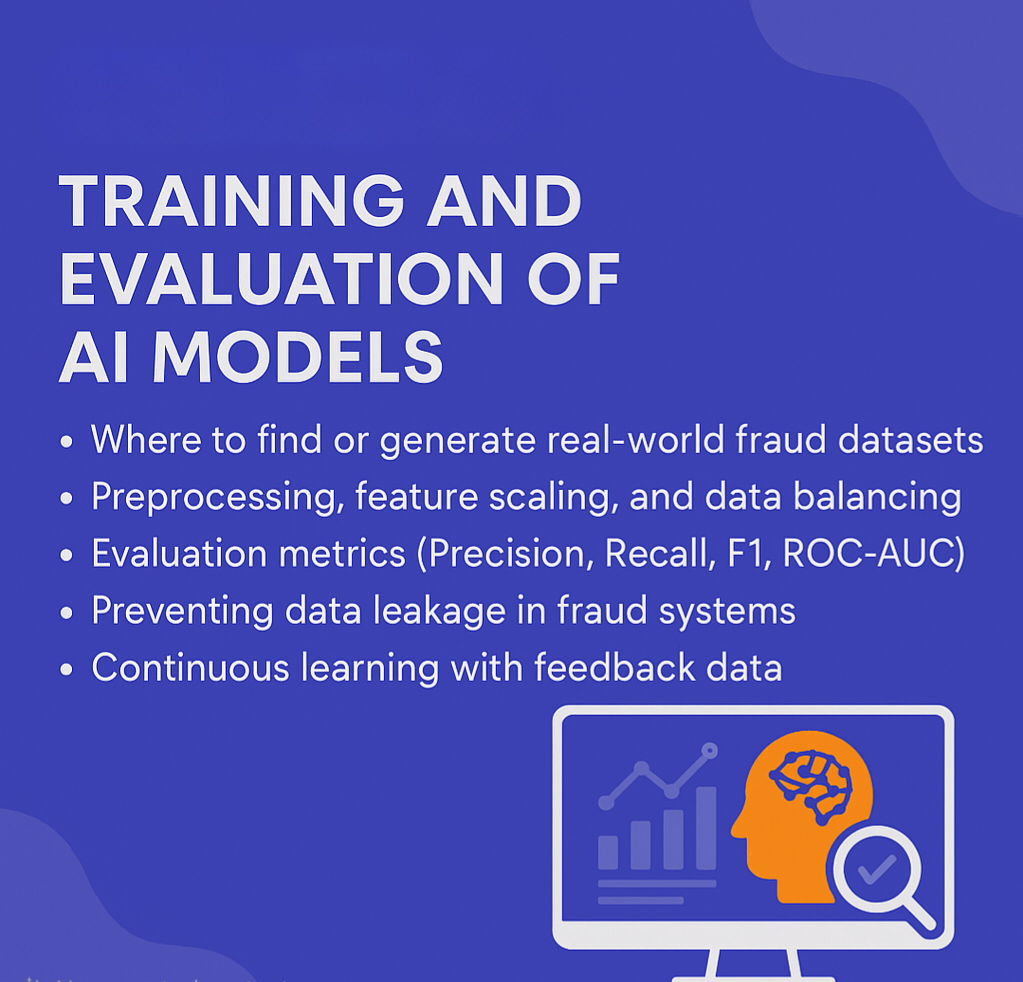In our previous blog post, we covered the foundational concepts for designing an AI-powered fraud detection system. Now, we’ll explore the core stage: training and evaluating your model so it performs reliably in real-world financial ecosystems.
A model is only as good as the data it learns from and the rigor with which it’s evaluated. In this guide, we’ll dive deep into:
- Sourcing real-world fraud datasets
- Preprocessing and balancing data
- Selecting meaningful evaluation metrics
- Avoiding data leakage
- Enabling continuous learning with feedback loops
1. Where to Find or Generate Fraud Datasets
Real-world fraud datasets are highly imbalanced and sensitive, making them difficult to access. However, there are some public datasets and synthetic generation techniques available for initial development and experimentation.
Publicly Available Datasets:
- Kaggle – Credit Card Fraud Detection: A popular dataset with anonymized features and clear fraud labels.
- IEEE-CIS Fraud Detection: Larger, complex dataset suitable for advanced models.
- Synthetic Financial Datasets For Fraud Detection (SFD-FD): Created to simulate real-world scenarios using statistical distributions.
Generating Synthetic Data:
Use tools like SMOTE or libraries such as Faker, SDV, or scikit-learn‘s make_classification() to generate training data that mimics real-world scenarios.
2. Data Preprocessing, Scaling & Balancing
Raw data is rarely ready for training. Here’s what you must do:
Preprocessing Steps:
- Replace or drop missing values.
- Engineer features like “transactions per hour” or “device changes per user”.
- Convert categorical variables using encoding techniques.
- Extract time-based features from timestamps.
Feature Scaling:
Use StandardScaler or MinMaxScaler to normalize numeric features. Only fit on training data to avoid leakage.
Handling Imbalanced Data:
- Use SMOTE or ADASYN to oversample minority class.
- Try under-sampling the majority class when feasible.
- Use class weights in models like Logistic Regression or XGBoost.
3. Evaluation Metrics That Matter
Accuracy is not a reliable metric for fraud detection. Focus on:
- Precision: How many predicted frauds were truly fraud?
- Recall: How many actual frauds did we catch?
- F1 Score: Balance between precision and recall.
- ROC-AUC: Overall classification ability.
- PR-AUC: Better for skewed classes.
Tip: False positives are expensive. Choose metrics based on business impact.
4. Preventing Data Leakage
Data leakage can cause inflated validation scores and failure in production. Avoid these:
- Including future info like “chargeback result” in features.
- Applying scaling before splitting data.
- Mixing data across different timeframes improperly.
Best Practice: Use time-based splits and test with future data.
5. Enabling Continuous Learning with Feedback
Fraud patterns change constantly. Your model must evolve too.
- Log predictions and compare with confirmed labels over time.
- Set up weekly or daily retraining pipelines.
- Consider online learning frameworks like River or Vowpal Wabbit.
- Use MLFlow or Airflow to manage retraining and deployment.
Example Workflow Summary
| Step | Tool |
|---|---|
| Data Collection | APIs, Public Datasets |
| Preprocessing | Pandas, Scikit-learn |
| Balancing | Imbalanced-learn (SMOTE) |
| Training | XGBoost, LightGBM |
| Evaluation | Scikit-learn metrics |
| Deployment | Flask, Laravel, FastAPI |
| Retraining | MLFlow, Airflow |
Final Thoughts
Training and evaluating fraud detection models is a complex but crucial task. It requires not just technical expertise, but strategic and ethical thinking. From proper data preparation to continuous improvement, every step must be deliberate.
The end goal isn’t just a high test score — it’s a production-grade AI model that protects users and builds trust.
Coming up next: How to deploy these fraud models securely with API integrations, real-time scoring, and automated alerts.
Have questions or want help setting this up? Leave a comment or reach out — we’d love to hear from you!

